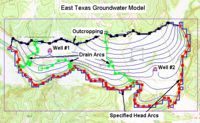GMS:Coverages: Difference between revisions
From XMS Wiki
Jump to navigationJump to search
| Line 22: | Line 22: | ||
=== 3D grid layer option for obs. pts === | === 3D grid layer option for obs. pts === | ||
The ''3D grid layer option for obs. pts.'' is used to set the input option for observations associated with MODFLOW conceptual models. Three options are available for determining which layer the observation point will be located: | The ''3D grid layer option for obs. pts.'' is used to set the input option for observations associated with MODFLOW conceptual models. The MODFLOW observation package can handle observations that include multiple cells.Three options are available for determining which layer the observation point will be located: | ||
*by z location - When the "by z location" option is selected, the computed value for the observation point (that will be compared with the observed value) will be taken from the cell that corresponds with the elevation value assigned to the observation point. | *by z location - When the "by z location" option is selected, the computed value for the observation point (that will be compared with the observed value) will be taken from the cell that corresponds with the elevation value assigned to the observation point. | ||
| Line 28: | Line 28: | ||
*by layer number - If you select the "by layer number" option in the coverage setup, the computed value will be taken from the cell that corresponds to the layer that is specified in the observation point coverage properties. | *by layer number - If you select the "by layer number" option in the coverage setup, the computed value will be taken from the cell that corresponds to the layer that is specified in the observation point coverage properties. | ||
*Use well screen - Use this option if you are using a well with a screen. | *Use well screen - Use this option if you are using a well with a screen. GMS finds the cell or cells that intersect the screened interval if the user has properly defined a screened interval for the point. | ||
The ''Default elevation'' field can be used to define the initial Z elevation of new objects created in a coverage. By assigning a different elevation to each of the coverages, the coverages can be displayed as a stack of layers in oblique view. | The ''Default elevation'' field can be used to define the initial Z elevation of new objects created in a coverage. By assigning a different elevation to each of the coverages, the coverages can be displayed as a stack of layers in oblique view. | ||
